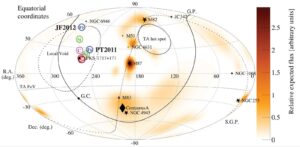High-energy cosmic rays “can simultaneously inform our knowledge of the most extreme processes in the Universe and of particle physics well beyond the energy reachable by terrestrial accelerators.”
The University of Utah’s Cosmic Ray Research program, along with partner institutions in the Telescope Array collaboration is looking to crack the case. The researchers’ recent observation of the second-highest energy cosmic ray on record is providing important clues.

At a seminar on campus Sept. 26, Jihyun Kim, senior research associate in the Department of Physics & Astronomy, presented the Cosmic Ray Research team’s findings from the Telescope Array, an international experiment based in the high desert of western Utah, where 850 detectors are arranged across half a million acres of public land, with 250 more on the way.
“We are hosting the experiment here in Utah,” Kim said. “We design, maintain, and operate everything. We go down with our students, and they learn how to operate all the systems, collect the data, and analyze it by themselves. This is a really unique research experience [for our students].”

Source: http://www.telescopearray.org/
She shared the latest research and insights pertaining to cosmic rays, utilizing the largest cosmic ray observatory in the Northern Hemisphere. The research group’s mission is to achieve breakthroughs in the field of particle astrophysics. Funded by the National Science Foundation, the Cosmic Ray Research program is particularly interested in the properties of ultra-high energy cosmic rays, or UHECRs.
This area of research is guided by a national planning effort for particle physics known as the Snowmass Process, which began in the eponymous Colorado town in 1982 and saw its most recent installment three years ago in Seattle. It is a collaboration between multiple universities, labs and government agencies to achieve a “collective vision” for future research.
Our understanding of astrophysics relies predominantly on light and electromagnetic waves, but cosmic rays are crucial for research as they offer insights unattainable through light alone. UHECRs are even more special. These are atomic-sized particles with extraordinary energies ranging from 10e18 𝑒𝑉 (electron volts—a particle-scale unit of energy) to beyond 10e20 𝑒𝑉.
When UHECRs collide with Earth’s atmosphere, they trigger extensive air showers or cascades of secondary particles. This naturally elicits the question: How can UHECRs be observed if they scatter?

The solution is cosmic retrodiction. In other words: the Cosmic Ray Research program can “reconstruct” a particle by analyzing observational data, which it obtains through a hybrid detection system, consisting of both fluorescence and surface detectors. Fluorescence detectors observe ultraviolet light in the atmosphere—useful for measuring longitudinal developments—whereas surface detectors, also called scintillators, sample the particle shower on the surface—an indicator for the shower’s lateral footprint.
The complementary data yielded by these two types of detectors allow researchers to not only simulate cosmic rays as they impact the Earth’s atmosphere but to model their travel path through the cosmos as well.
they are observable. Up to a threshold, UHECRs show an anisotropic pattern, wherein they appear to originate from several “hotspot” regions (Figure 2).

However, when we consider the detection patterns of the highest-energy particles, they follow an isotropic distribution, oftentimes isolated from known bright objects like the M87 supermassive black hole—5 billion times the mass of our sun (Figure 3).
“I think that is an exciting thing,” Kim said. “When we have an unexpected result, there are two ways we can [analyze] it. We can find an underlying new phenomenon, lead to new physics, or we could be wrong! But before that situation, we can try this and that. And then lots of exciting ideas can be brought up!”
Theories regarding the intense levels of energy inherent in these particles include: “transient event[s] in an otherwise undistinguished galaxy;” electroweak monopole particles; binary neutron star mergers; and ultra-heavy element compositions, such as platinum or tellurium. However, no theory has been proven definitively to match the latest observations.

“You’d expect [to find] a high electric field, high magnetic field. Where the particle is confined while it’s being accelerated. There aren’t that many objects that meet these requirements, especially at the highest energies,” said John N. Matthews, Cosmic Ray Physics program manager. “They’re coming from nowhere or everywhere. So either there’s something we don’t understand or [we explore] other possibilities.”
The prospect of diving into the unknown is an exciting one. Though, as the mantra in scientific research goes: “More data is needed.” A particular issue with UHECRs, however, is their comically low appearance rate—just one detection per square kilometer for every 100 years. To tackle this, the Telescope Array is thinking big by quadrupling the size of the array outside Delta, Utah to approximately 2,800 square kilometers, or nearly 700,000 acres. The expansion is about halfway completed.
The increased operational space would enable a faster rate of data collection—allowing the Cosmic Ray Research program to fine-tune its model and prediction. Additionally, it could offer insights into the existence of particles with greater amounts of energy than those previously recorded. The current record is the “Oh My God” particle, roughly 3. 2 * 10e 20 𝑒𝑉, which U researchers observed on Oct.15, 1991.
Moreover, the project’s expansion would offer new opportunities and benefits for the community and university students.
“You’re satisfying human curiosity and man’s desire to understand and man’s desire to explore,” Matthews said. “You’re solving problems that you didn’t expect. You’re understanding the cosmos, you’re understanding the world—the universe we live in. And maybe along the way, you create an invention that has a broader application [for our society].”
The vision of discovering new insights into particle astrophysics and the origins of UHECRs is both exciting and compelling. Through the expansion of observational sites, the maturation of technology, and the inexhaustible zeal of students and researchers alike, the U research community is poised to unravel this astrophysical enigma and enrich our understanding of the cosmos.
MEDIA & PR CONTACTS
-
Lisa Potter
Research communications specialist, University of Utah Communications
949-533-7899 lisa.potter@utah.edu
